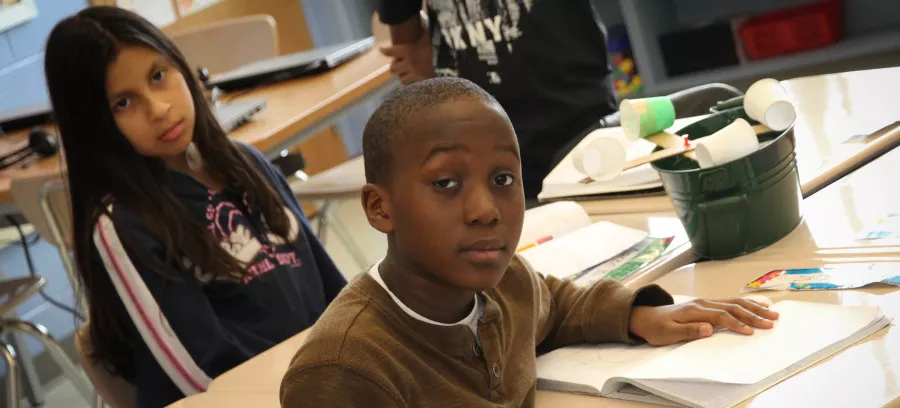 The fiscal outlook in most states has improved since the Great Recession, but the recovery - much like the U.S. economy as a whole - is far from complete. Nowhere is this more evident than in the nation's public schools. Education was one of the first areas that incurred massive budget cuts when the economy tanked in late 2008. Now almost eight years later, we still have a long way to go before education funding returns to pre-recession levels, A new analysis by the Center on Budget and Policy Priorities (CBPP) lays out a distressing picture of how slow and painful the recovery has been for the nation's students. Not only have funding levels not recovered, but some states are still cutting.
The fiscal outlook in most states has improved since the Great Recession, but the recovery - much like the U.S. economy as a whole - is far from complete. Nowhere is this more evident than in the nation's public schools. Education was one of the first areas that incurred massive budget cuts when the economy tanked in late 2008. Now almost eight years later, we still have a long way to go before education funding returns to pre-recession levels, A new analysis by the Center on Budget and Policy Priorities (CBPP) lays out a distressing picture of how slow and painful the recovery has been for the nation's students. Not only have funding levels not recovered, but some states are still cutting.
Education funding is split almost evenly between state and local funding sources with the federal government chipping in the rest (roughly nine percent). It's an inherently inequitable formula due to the reliance on local property taxes. Lower-income districts can't begin to provide adequate support for their schools when state lawmakers slash education spending, as they did across the country when the recession hit in 2008 and 2009. As the fiscal outlook darkened, lawmakers relied disproportionately on severe spending cuts - a shortsighted policy that remains largely entrenched. As the CBPP report points out, these austerity measures have only undermined growth and investment:
State K-12 cuts have slowed the economic recovery by reducing overall economic activity since the recession officially ended in mid-2009. They forced school districts to lay off teachers and other employees, reduce pay for the remaining workers, and cancel contracts with suppliers and other businesses. These steps remove consumer demand from the economy, which in turn discourages businesses from making new investments and hiring.
CBPP reports that at least 31 states provided less state funding per student in the 2014 school year than in the 2008 school year. And in at least 15 states, those cuts exceeded 10 percent. (Note: a few states, including California, were not included in this analysis due to unavailability of the necessary data).
 Local education funding per student hasn't fared much better, falling in 18 states over the same period. Local funding has ticked up in 27 states but not enough to recover the losses from the deep spending cuts at the state level.
Local education funding per student hasn't fared much better, falling in 18 states over the same period. Local funding has ticked up in 27 states but not enough to recover the losses from the deep spending cuts at the state level.
One of the most critical education investments state and local governments make is new school construction, renovation and modernization. These expenditures - known as "capital spending" - have been severely cut since the recession. According to CBPP, elementary and high schools across the nation had to slash capital spending $28 billion (37%) between 2008 and 2013. Some of the cuts have been extreme, as much as 50% in five states. In addition, student enrollment has increased by more than 800,000 since 2008, while education jobs have decreased by almost 300,000.
Most state coffers may not currently be flush with cash, but blaming a less-than-robust economy for underfunding public education ignores the misguided policies many lawmakers have pursued. Ignoring a more balanced fiscal approach, they feverishly slashed spending without taking a hard look at new revenues. Not only are many states clinging to this failed strategy, but some have even cut taxes while continuing to reduce education funding. The CBPP survey points to four states - Arizona, Idaho, Oklahoma, and Wisconsin - that have cut income taxes since 2008, while imposing the deepest education cuts in the country.
 Perhaps the most notorious (and disastrous) model can be found in Kansas, led by Gov. Sam Brownback, but because the state eliminated its funding formula in 2015, CBPP was unable to determine the size of the cuts. What is certain, however, is that Kansas ranks 48th in the nation in job growth and remains mired in a fiscal crisis. Unfortunately, Kansas and too many states refuse to change course.
Perhaps the most notorious (and disastrous) model can be found in Kansas, led by Gov. Sam Brownback, but because the state eliminated its funding formula in 2015, CBPP was unable to determine the size of the cuts. What is certain, however, is that Kansas ranks 48th in the nation in job growth and remains mired in a fiscal crisis. Unfortunately, Kansas and too many states refuse to change course.
"These trends are very concerning to the country’s future prospects," the CBPP report states. "Our country’s future depends crucially on the quality of its schools, yet rather than raising K-12 funding to support proven reforms such as hiring and retaining excellent teachers, reducing class sizes, and expanding access to high-quality early education, many states have headed in the opposite direction."
Photo: Luis Gomez







